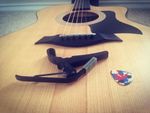 Music feeds the soul. It can make us happy and relaxed. Whether you're listening to music or playing your instrument it can bring forth fruits that make life just a bit sweeter.
Music feeds the soul. It can make us happy and relaxed. Whether you're listening to music or playing your instrument it can bring forth fruits that make life just a bit sweeter.
I’ve been playing the piano and guitar for a very long time. No matter what kind of day I’ve had, my instruments are always waiting for me. They are an extension of me. We know each other so well. If you are passionate about music the last thing you want is to abandon something that is near and dear to you like your instrument.
Playing an instrument is a wonderful stress reducer, increases endorphins which makes you happy and it can also make you smarter. Learning builds new brain cells. Plus it also enhances creativity.
With all that said comes one word–practice.
Learning an instrument, like so many things, takes dedication. It takes practice in order to get better. There will be some days you’re not available to practice. Something comes up. When you do have time to practice take full advantage of that precious time with your instrument. Then there are times where you have to make time to practice. If you notice it’s been several days since you’ve played your instrument, you may need to reconfigure your schedule. Some people get so busy they have to schedule practice time and that's OK. Sometimes our downtime consists of social media, the Internet, music and video streaming. Leisure time is very important. Some of that leisure time can be spent practicing.
If music practice comes across more like homework and less like leisurely fun then we have to re-think what practice is and how we should go about it.
Practice is not homework.
Practice may take some work, but it shouldn’t be viewed as school-work or work-work for that matter. Practice should be thought of as something FUN. It’s a time to relax and have fun with your instrument. With that in mind here are some easy ways to approach practice time.
A general rule of thumb is to practice at least 30 minutes a day. But if you can only squeeze in 10 or 15 minutes a day, it’s better than no practice at all.
Divide practice into three simple parts: a "warm-up," new material, and a "cool-down." Spend a few minutes warming up. Something fun, easy, and a song you really enjoy to play. Warming up gets you mentally and physically prepared to play. It helps to get into a positive mood to practice. Once you’re nice and settled in, spent the greater part of your practice time working on the new material. Whatever was recently learned in a lesson for instance. Play it over and over...and over...and over again. Working on the new material should be done, not by how many repetitions, but by how many minutes you play it. So, if you practice the new material for 10 minutes, that could equate to many, many play-throughs, and that’s good! Repetition is an effective learning tool.
While you're practicing don't forget to bite-size. Bite-sizing is a method I came up with where a student plays each measure three or more times, then the entire musical line (wash, rinse, repeat).
The last few minutes of practice may be spent in a variety of ways, such as with another “fun” piece you really enjoy. You could also work on something original for some added creativity, or play along with a cover song.
This method could be viewed as a “practice sandwich.” Sandwiching some songs that are “more fun” with the new lesson material is one approach, especially if the new material is a little dry. The goal is to continue to learn, continue to get better at your instrument, all the while having fun.
